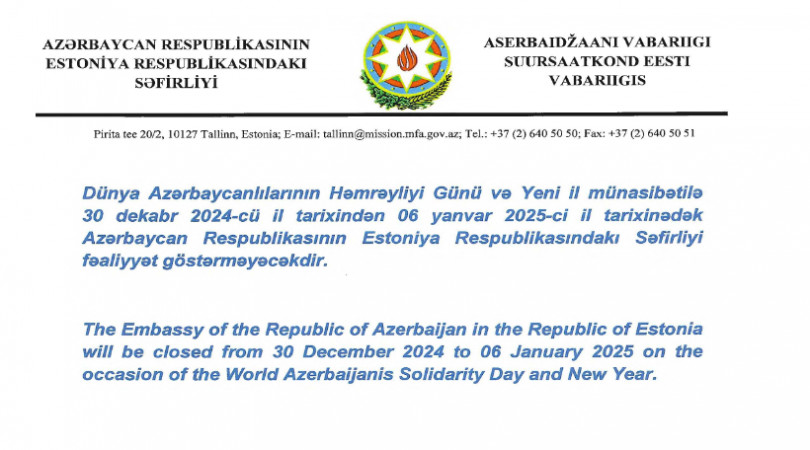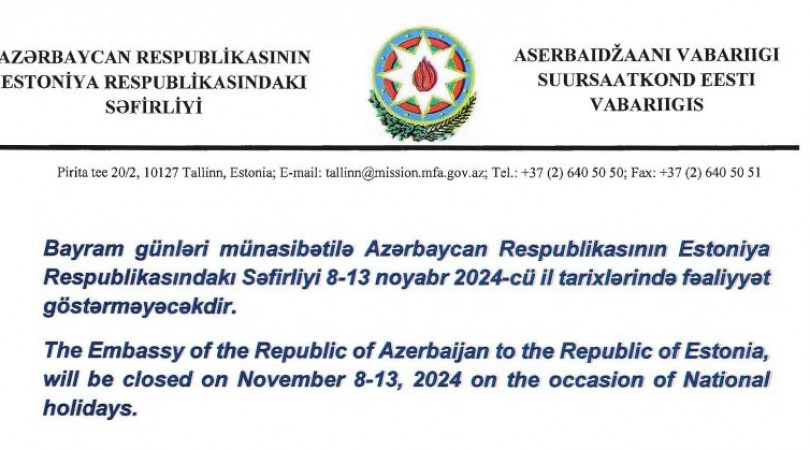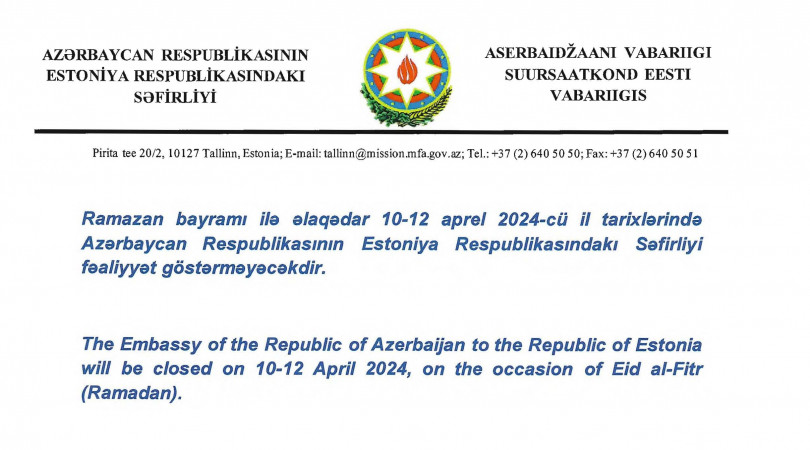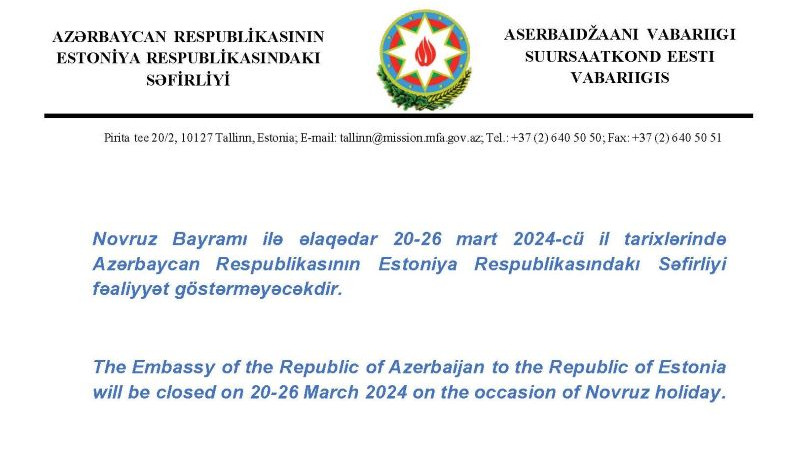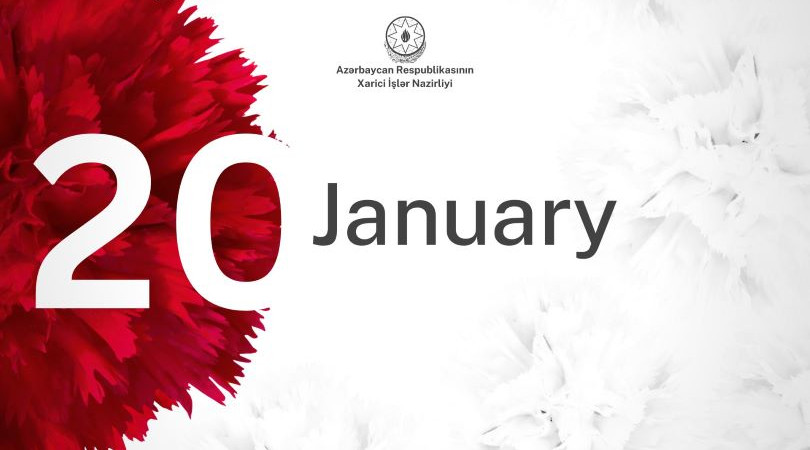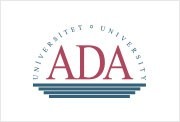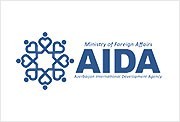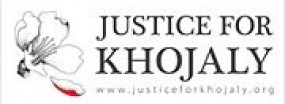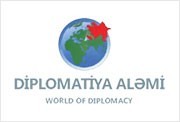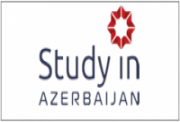31. märtsi genotsiid on Armeenia poolt aserbaidžaanlaste vastu suunatud etnilise puhastuse poliitika veriseim lehekülg
Resettlement of the Armenians to Azerbaijani lands
The policy of ethnic cleansing, genocide and aggression deliberately carried out by Armenian nationalists against our people over the past two centuries represents extremely painful and tragic stages in the history of Azerbaijan, including bloody events. The main objective of this nationalist and chauvinist policy was to oust the Azerbaijanis from their ancestral lands and to create a fictional state of "Great Armenia" on Azerbaijani territories. Historical facts indicate that the resettlement of numerous Armenians from Iran and Turkey to the mountainous part of Karabakh region of Azerbaijan, which represented tremendous importance in strategic terms, was carried out from the beginning of the 19th century. Over this period, the Imperial Russia, which sought to establish control over the region's vast natural resources, used the "Armenian factor" as a political tool in the war against Turkey and Iran in the late 19th and early 19th century.
At the beginning of the 19th century, the commander-in-chief of the Russian troops in the Caucasus, P.D.Tsitsianov, having occupied Ganja, wrote in his report No 19 dated 22 May 1805 that in terms of its geographical location Karabakh is considered the gateway of Azerbaijan and Iran, therefore, "we need to keep it under control and apply even more effort to strengthening our positions here". This goal was soon achieved. On 14 May 1805, an agreement was signed between Karabakh Khan Ibrahim and General Tsitsianov. As soon as the Karabakh khanate became part of Russia, P. D. Tsitsianov immediately began to resettle the Armenians from other provinces of the South Caucasus in order to strengthen the positions of czarism in Karabakh.
According to the "Description of the Karabakh province", an important document prepared by royal officials Yermolov and Mogilev and providing detailed information on the ethnic composition of the Karabakh population, the Karabakh pro¬vince in 1823 was home to 20,095 families, including 15,729 Azerbaijanis and 4,366 Armenians.In other words, before 1823 the number of Armenian families in the province was increased on the account of settlers to reach 4,366.
A significant increase in the number of the Armenians in the mountainous part of Karabakh took place in the 1920s, especially after the Russian occupation of the South Caucasus. As a result of mass resettlement of the Armenians in the Russian-Iranian war of 1804-1813 and 1826-1828, the Russian-Turkish war of 1828-1829, and then from Iran, Turkey and South Azerbaijan to the South Caucasus, their numbers here started to increase with every year. N.N.Shavrov openly talks about the occupation of the Caucasus by czarist Russia and writes about the first resettlement to these territories of representatives of other nationalities: "We started our colonial activities with the relocation not of the Russian population, but foreigners to the Caucasus. Of these colonists, who were unwelcome elements at home, we created colonies in Tiflis and Yelizavetpol (Ganja) provinces. The best lands were allocated to them and various privileges provided".
A total of 124,000 Armenians were initially resettled to the mountainous part of Karabakh officially, followed by a large number of those resettled unofficially. Overall, more than 200,000 Armenians were resettled to the mountainous part of Karabakh in 1828-1830s. This is how N. N. Shavrov describes these facts: "After the war of 1828-1830s we moved more than 40,000 Iranian and 84,000 Turkish Armenians and settled them in Yelizavetpol and Erivan provinces, as well as the best public lands of Tiflis, Borchali, Akhaltsikhe and Akhalkalaki districts, where the Armenians practically did not live. More than 200,000 tithes of state lands were allocated for their resett¬le¬ment. Besides, special farming lands worth in excess of 2 million rubles were acquired from the Muslims. These Armenians were settled in the mountainous part of the Yelizavetpol province (the mountainous part of Karabakh is implied) and on the shores of Lake Goycha. It should also be noted that the number of Armenian settlers together with those resettled unofficially exceeded 200,000 people".
This fact indicates that the Armenians were mainly settled in areas where the Armenians did not live or their number was insignificant. Hence it is clear that before the beginning of the 19th century, in particular before the conclusion of the Treaty of Turkmenchay, the number of Armenians in Ganja and Erivan provinces was negligible. Thus, in the two years following the signing of the Treaty of Turkmenchay, the Armenians, thanks to the patronage of czarist Russia, managed to settle in different regions of Azerbaijan, including the mountainous part of Karabakh. This czarist patronage of the Armenians manifested itself in subsequent years as well.
At the end of the 19th and beginning of the 20th centuries, the resettlement of Armenians to the South Caucasus was continued. In 13 years from 1896 to 1908, a total of 400,000 Armenians were resettled to the Caucasus. N. N. Shavrov writes about this: "In 1896, Adjutant-General Sheremetyev wrote in a note about the Armenians living in the Caucasus that their number was around 900,000 people. In 1908, their number reached 1,300,000, i.e. over this period the number of Armenians increased by more than 400,000 people. Of 1,300,000 Armenians living in the Caucasus at the moment, one million people are not indigenous to the region. They were resettled here by us".
In general, the resettlement of Armenians to the moun-tainous part of Karabakh had a huge impact on the demog-raphic situation in the region. It is noted that the public census carried out in 1897 revealed that of 54,841 families living in Karabakh 29, 350 families were Azerbaijani and 18,616 Armenian. In 1917, the number of Armenians in Karabakh increased at the expense of settlers to reach 46 per cent, while the Azerbaijanis accounted for 51 per cent of the total population.
In 1917, the "Caucasian Calendar" digest wrote that Karabakh was home to 199,000 Azerbaijanis (58.3 per cent) and 142,000 Armenians (41.7 per cent). As can be seen, despite the fact that thanks to the patronage of czarist Russia the Armenians were artificially resettled to and placed in Karabakh in stages, the Azerbaijanis as original inhabitants of these lands always formed the majority. The statistics provided in the "Caucasian Calendar" proves that the number of Azerbaijanis by far exceeded that of the Armenians even on the present-day territory of Armenia. For example, in 1886, of 326 villages in Zangezur district of Ganja (Yelizavetpol) province 154 were Azerbaijani (45.7 per cent), 91 Kurdish (27.8 per cent) and only 81 Armenian (24.8 per cent).
In 1889, the Azerbaijani population of Zangezur district exceeded that of Armenians by 1,500 people. In 1897, the population of Zangezur was 142,000 people, including 71,200 of Azerbaijanis (50.1 per cent) and 63,600 Armenians (44.8 per cent). The statistical digest of the Central Statistical Office of Armenia published in 1962 states that out of 18,766 people living in Erivan in 1831 as many as 15,992 and out of 27,246 inhabitants of Erivan in 1866 23,627 people were Azerbaijanis (i.e. 85.2 per cent of the population).
The book titled "The Population of Soviet Armenia in 1831-1931" published by Z. Korkodyan in Erivan in 1932 also notes that out of 2,310 settlements of Erivan, Echmiadzin, Yeni-Bayazid and Alexandropol areas of Erevan province, Zangezur and Gazakh-Dilijan areas of Yelizavetpol (Ganja Province) and Lori-Pembek area (Borchali district) of Tiflis province, 2,000 were Azerbaijanis. Of 10,000 people living in Erivan, 7,000 people were Azerbaijanis, including all 40 people who ran the Khanate.
In the districts of Erivan province that were part of Azerbaijan until 1920, in particular the Erivan district, the Azerbaijani population was much greater. For example, of 99,000 residents of the district 62,600 (66 per cent) were Azerbaijanis and 36,400 Armenians (34 per cent).
In Echmiadzin, Yeni-Bayazid and Surmeli districts of Erivan province the Azerbaijanis accounted for a third of the population. As of 1 January 1916, the ethnic composition of the population in these districts was still in favor of the Azerbaijanis. Erivan district was home to 74,200, or 48 per cent, Zangezur district to 119,500, or 53.3 per cent, Yeni-Bayazid to 50,700 and Surmeli to 45,000 Azerbaijanis. These figures clearly show that in the 19th and early 20th centuries Azerbaijanis formed the majority of the local population on the territory of the present-day Armenia.
At the end of the 19th century, in 1885, Armenian nationalists established the "Armenakan" Party in Marseille, "Gnchag" in Geneva in 1887 and "Dashnaktsutyun" in Tbilisi in 1890. Following this, Armenian efforts to create a "Great Armenia" entered a new stage.
Armenian policy of ethnic cleansing and genocide against the Azerbaijanis in the early 20th century
The process of resettlement, which was an integral part of the colonial policy of czarist Russia, continued throughout the 19th century and eventually influenced the demographic situation in the region. The artificial increase of the number of Armenians in the region contributed to the fact that starting from the beginning of the 20th century they began to put forward territorial claims and pursue an aggressive policy against Azerbaijan.
In the early 20th century, Armenian nationalists expanded their activities towards the idea of a "Great Armenia" put forward by the “Dashnaktsutyun” Party, systematically expel¬led Azerbaijanis from their historical lands and native homes and embarked on a policy of ethnic cleansing and genocide. For example, in 1905-1906 the Armenians committed mas¬sacres against Azerbaijani civilians in Baku, Ganja, Karabakh, Erivan, Nakhchivan, Ordubad, Sharur-Daralayaz, Tiflis, Zangezur, Gazakh and other places, perpetrated ruthless massacres against the local population, burned and destroyed cities and villages. Armenian armed forces destroyed more than 200 Azerbaijani villages in Shusha, Zangezur and Jabrayil district, Erivan and Ganja provinces, tens of thousands of our compatriots were expelled from their homes and became refugees and IDPs. After indiscriminately killing more than 200,000 Azerbaijanis (children, women and the elderly), the Armenians carried out ethnic cleansing to create an “Armenian state” on these territories promised to them by czarist Russia. Thus, the Armenians who also enjoyed the patronage of czarism during World War One, continued to inflict punishment on Azerbaijanis.
After the developments that occurred in Russia in February and October of 1917, the “Dashnaktsutyun” Party and the Armenian National Congress launched even wider activities. At the same time, S. Shaumyan, who was appointed as temporary emergency commissioner on the Caucasus by V. Lenin in December 1917, organized and led a campaign of mass extermination of the Azerbaijanis. In the time period from April 1917 to March 1918, Armenian armed forces destroyed 197 villages in Erivan province, 109 villages in Zangezur district and 157 villages in Karabakh, and destroyed, burned and razed to the ground 60 settlements in other regions.
In early 1918, i.e. on the eve of the March massacre, the number of Armenian armed forces that reported directly to the Shaumyan constituted nearly 20,000 people. With the support of the Bolsheviks, including Lenin, Shaumyan became the leader of the Baku Commune. On 30 March of that year, Armenian-Bolshevik units subjected Baku to volley fire from ships. Then armed Dashnaks attacked the homes of Azerbaijanis and staged merciless slaughter. On 31 March and in the first days of April, the carnage became even more ruthless. Thousands of Azerbaijani civilians were killed only because of their ethnicity. In those days, Armenian-Bolshevik units destroyed 12,000 Azerbaijani civilians in Baku. During those bloody events people were burned in their homes, killed and tortured with unparalleled cruelty.
As a result of an armed attack by the Armenians, more than 16,000 people were killed with utmost cruelty in Guba province in the first five months of 1918, a total of 167 villages were destroyed, of which 35 do not exist to this day. The facts of mass extermination of the Azerbaijanis of Guba district by Armenian-Dashnak gangs have been recently proven again. Thus, the discovery in 2007 of mass graves in Guba is a fact confirming Armenian vandalism. The study of the burial site has revealed that during an Armenian armed attack on Guba in 1918 people were subjected to unprece¬dented violence and killed with cruelty. The grave contains remains of mass burials of local residents. It should also be noted that Armenian armed forces under the command of Amazasp also slaughtered the local Jews along with the Turkic-Muslim population. The research has established that in 1918-1919 the Armenians massacred about 3,000 Jews in Guba.
In addition, hundreds of settlements were destroyed and burned in Azerbaijan, including more than 150 villages in Karabakh. A ruthless massacre of the Azerbaijanis was perpet¬rated in Shusha. In March-April 1918, Armenian Dashnaks tortured and killed about 50,000 people in Baku and other regions of Azerbaijan. More than 10,000 people were ruthlessly slaughtered in Zangezur district, 10,270 in Shamakhi district and 18,270 Azerbaijanis in the city of Shamakhi.
In 1918-1920, of the 575,000 Azerbaijanis living on the territory of the present-day Armenia, 565,000 people were killed and expelled from their native lands. Confirming this figure in a book called "Population of Soviet Armenia in 1831-1931", Z. Korkodyan writes that "in 1920 the Soviet govern¬ment inherited a little more than 10,000 Turkic (Azerbaijani) population from the Dashnaks. In 1922, after the return of 60,000 Azerbaijanis refugees there were 72,596 people and 105,838 in 1931." In the last two months of 1919, a total of 96 villages were destroyed in Echmiadzin and Surmali districts, all villages in Erivan district and 132,000 Azerbaijanis in Erivan province.
Overall, as a result of the incessant and ruthless massacres unleashed by the Armenians in 1918-1920, tens of thousands of Azerbaijanis were killed and more than a million people were expelled from their native lands in Baku, Guba, Shamakhi, Lankaran, Kurdamir and Shusha, on the territory of Erivan province, Zangezur, Nakhchivan, Sharur, Ordubad, Kars and other regions. When committing these atrocities on historical Azerbaijani lands, the Armenians burned schools and mosques and destroyed samples of material culture.
After formation of the Azerbaijan Democratic Republic on 28 May 1918, the Extraordinary Commission of Inquiry was established to investigate the crimes committed by the Arme¬nians. By a resolution of the Government it was decided to mark 31 March of each year as a day of mourning (31 March 1919 and 1920 was marked as a national day of mourning). However, the fall of the Azerbaijan Democratic Republic prevented completion of this work. The geopolitical situation that existed in the region during the formation of the Azerbaijan Democratic Republic led to the transfer, on 29 May 1918, of the city of Erivan to the Armenians as a political center. Thereby, the Republic of Armenia was formed on Azerbaijani lands, on the territory of the former Erivan khanate, in 1918.
The artificial increase of the number of Armenians in the mountainous part of Karabakh as a result of the resettlement, which was part of a colonial policy of czarist Russia that continued throughout the 19th century, led to the fact that in early 20th century they began to put forward territorial claims and conduct aggressive policy against Azerbaijan. The biggest claim of the Armenians was on Karabakh and Zangezur. The Armenian government, seeking to implement these aggressive plans, sent armed forces there. As a result, the Armenian armed forces seeking to capture Karabakh destroyed hundreds of settlements and mercilessly massacred thousands of innocent Azerbaijanis. In January 1919, the Dashnak govern¬ment of Armenia leveled another claim related to Karabakh against Azerbaijan. This represented the first official attempt to attach the mountainous part of Karabakh to Armenia. The Azerbaijani government made repeated proposals to resolve the problem by peaceful means. But the position of Dashnaks prevented their realization.
The Azerbaijan Democratic Republic, which considered preservation of the territorial integrity and security of citizens its main duty, categorically rejected the territorial claims of the Republic of Armenia. After discussing the Karabakh issue, the Parliament of Azerbaijan started the implementation of specific measures to curb separatist movement. To this end, the Government of Azerbaijan on 15 January 1919 separated Shusha, Jabrayil, Javanshir and Zangezur districts from the Ganja province, formed the Karabakh governor-generalship with a center in the city of Shusha and appointed Khosrov Sultanov as Governor General. The Azerbaijani government instructed him to establish order there and set up local authorities.
Thanks to the strenuous efforts of the government of Azerbaijan, with the mediation of the United States Mission, Azerbaijan and Armenia signed a treaty in Tbilisi on 23 No¬vember 1919. According to the signed agreement, clashes were to be suspended, controversial issues, including those related to border issues, should be resolved through negotiations. However, the Armenian side grossly violated the agreement, sent troops to Azerbaijani territories and arranged a monstrous massacre of Azerbaijanis. Despite all this, during the existence of the Azerbaijan Democratic Republic, Arme¬nian attempts to seize Karabakh in diplomatic and military means were strongly suppressed. However, after the sovieti¬zation of Azerbaijan, these territorial claims of Dashnaks, who played a significant role in the fall of Azerbaijan Democratic Republic, resurfaced again. Using the sovietization of the South Caucasus in their own interests, the Armenians in 1920 declared Zangezur and a number of other Azerbaijani lands as being part of the Armenian SSR. In subsequent periods they further extended the policy of deportation of Azerbaijanis who had historically lived in these areas.
The Armenians, who used the sovietization of the South Caucasus in their own interests, managed to include Zangazur and a number of Azerbaijni territories in the Armenian SSR. Thus, Nakhchivan was geographically separated from Azerbaijan, and its land communications with the country were cut. In the following years the Armenians extended the policy of deporting Azerbaijanis from Zangazur, which was given to Armenia, and from the other areas where the Azerbaijanis have historically lived.
As a continuation of this policy, on July 7, 1923 the Armenians who were resettled in the mountainous part of the Karabakh region in the 19th century, were given the status of an autonomous region . This decision was implemented under the auspicies and with the involvement of the Soviet Russia. However, many more Armenians were living in other Soviet republics than in Karabakh. Moreover, despite the fact that the number of Azerbaijanis historically living in Armenia exceeded the number of Karabakh Armenians several times, Azerbaijan never demanded Armenia to establish a national or state organization for them. Besides, when the NKAO was established, the administrative and territorial division of Azerbaijan, which existed before 1923, was grossly violated and in accordance with the decision, NKAO was established through division of the territories of Javanshir, Gubadli, Shusha districts.
Under the “Statute”, Shusha, Khankandi and 115 villages in Shusha district, 52 villages in Javanshir district, 30 villages in Garyagin district, and Galadarasi from Gubadli district were included in NKAO.
As a result, Karabakh, an integral part of Azerbaijan, was artificially divided into lowland and mountainous areas and the Azerbaijani leadership was forced to grant the Armenians, who were settled in the mountainous part of Karabakh, the status of autonomy. At the same time this status of autonomy was implemented without taking into account the opinion of the Azerbaijanis historically living in Nagorno-Karabakh and by grossly violating their rights.
This event was not only a violation of the administrative and territorial division of Azerbaijan, but also became a tool for future territorial claims of Armenia against Azerbaijan and since then the term of "Nagorno-Karabakh" has appeared. Although a decree on the establishment of autonomy showed Khankandi as the regional center, shortly after that on September 18, 1923 by the decision of the Nagorno-Karabakh regional party committee Knankandi was renamed Stepanakert in honor of Sergey Shaumyan. Thus, the foundation was laid for the renaming historical Azerbaijani places, towns, districts and villages in Karabakh.
Although in Soviet times, the Armenian community of the Nagorno-Karabakh region of Azerbaijan enjoyed autonomy, covering all political, economic, social and cultural issues, Armenia repeatedly put forward territorial claims, but failed to achieve its goal. Instead, as a result of the mass deportation of Azerbaijanis in 1948-1953 from their historical lands, particu¬larly from Yerevan and the surrounding areas, in accordance with the 23 December 1947 decree of the Council of Ministers "On the resettlement of collective farmers and other Azerbaijani population from the Armenian SSR to the Kur-Araz lowland of Azerbaijan SSR" about 150,000 of our compatriots were forcibly resettled in low-lying areas of Azerbaijan.
Territorial claims and military aggression of Armenia against Azerbaijan in the late 20th century
In the late 1980s the Armenians with the help of their patrons in the near and far abroad and using the situation to implement the idea of "Great Armenia", made territorial claims to the Nagorno-Karabakh region of Azerbaijan. Whenever territorial claims to Karabakh were brought forth from the outside under the influence of propaganda, incitement and pressure by the Armenian side, they did not occur immediately, but even before that were prudently prepared by supporters in Yerevan and in the West, also on the basis of a comprehensive plan.
In Soviet times, central authorities have launched a deliberate propaganda campaign against Azerbaijan, which formed a negative public opinion. Armenian ideologists and their inspirers brazenly manipulated information about the history and socio-economic development of Azerbaijan. When the events of 1988 just started, long rallies and demonstrations were organized, the work of enterprises was halted in Khankendi and Yerevan under a deliberate plan to annex the Nagorno-Karabakh to Armenia under the pretext of economic backwardness of the region which was elaborated by Armenian politicians, who were trying to aggravate the situation and mislead the public opinion, and their patrons in the center.
However, subsequent events showed that a false thesis on the socio-economic plight of the Nagorno-Karabakh professed by Armenian politicians and their patrons in the center, was just a pretext, while the main goal was the territorial claims of Armenia against Azerbaijan. Armenian-Azerbaijani ethnic hostilities escalated in the second half of 1980, when the Azerbaijani community of the Nagorno-Karabakh was brutally attacked. So, in late August and early September, the Armenians attacked Khojaly and Kyarkidzhahan. On September 18 nearly 15,000 Azerbaijanis were driven out from Khankendi by Armenians.Their homes were burned out.
On December 1 1989 the Supreme Soviet of the Armenian SSR contrary to the Constitution took a decision to annex the Nagorno-Karabakh, grossly violating the sovereignty of Azerbaijan. Enterprises of the Nagorno-Karabakh were subordinated to the relevant ministries and departments of Armenia. As a direct result of inaction and even open patronage of the Soviet leadership the Nagorno-Karabakh's economy and other spheres actually seceded from Azerbaijan and joined Armenia. All party district committees were included in the Communist Party of Armenia. The flag of Armenia was raised in the Nagorno-Karabakh. Very serious and inexcusable errors, pro-Armenian policy of the Soviet leadership led to the aggravation of the situation in late 1990 - early 1991 when Armenian aggression took a broader scale in the Nagorno-Karabakh and adjacent regions of Azerbaijan. Hundreds of Azerbaijanis were killed in a Baku-Moscow train and Tbilisi-Baku, Tbilisi-Agdam, Agdam-Shusha, Agdam, Khojaly bus terrorist attacks. Thousands of Azerbaijanis became victims of Armenian policy of aggression, which was patronized by the USSR establishment.
Unfortunately, nobody stopped the Armenian separatists at the beginning, and it just escalated the situation. As a result, receiving both Armenian and Russian material and military support, Armenians committed mass killings of Azerbaijani civilians and these bloody crimes against the Azerbaijanis led to a further widening of the conflict and its expansion into a full-fledged war.
In 1991 the tension in the mountainous part of Karabakh started to gradually worsen. Socio-political situation has already foreshadowed the approach of a major disaster. In June and December of 1991 Armenian armed forces killed 12 and wounded 15 Azerbaijanis in the village of Garadagli in Khojavand region and Meshali village in Askaran region. In August and September of the same year, 17 Azerbaijanis were killed and 90 injured when the Armenian armed detachments shelled buses en route Shusha-Jamilli, Agdam-Khojavend and Agdam-Garadagli.
At the end of October and in November 1991 the Armenians burned, destroyed and looted more than 30 settlements in the mountainous part of Karabakh, including Tyr, Imaret-Gervend, Syrkhavend, Meshali, Jamilli, Umudlu, Garadagli, Karkijakhan and other villages of strategic importance.
In general, from 1988 to 1991, that is, from the beginning of the events until the collapse of the Soviet Union, patronized by the ruling circles of the USSR, Armenia pursued an aggressive policy against Azerbaijan. As a result of this policy, the Azerbaijani civilians were killed, their villages were destroyed, burned and looted. Aggressive state artificially instilled Armenians living in Nagorno-Karabakh region the idea of separation from Azerbaijan and unification with Armenia. To achieve this goal the Armenians subjected to genocide 50,000 Azerbaijanis of Nagorno-Karabakh and forced them to leave their homeland. During these years, Armenians committed 2,559 clashes, 315 armed attacks and 1,388 fires, killing 514 and injuring 1,318 people in the Nagorno-Karabakh.
At the same time during this period as a result of ethnic cleansing an estimated 250,000 civilians living in 185 Azerbaijani villages in Armenia were subjected to aggression and were forced to leave their homes. It was an action of ethnic cleansing, 216 Azerbaijanis were savagely killed, thousands of women, children and old people were injured and property was looted.
In the beginning of 1992, the Armenian army occupied the last Azerbaijani villages in the Nagorno-Karabakh. On February 12 1992 the Armenian armed forces occupied Malibeyli and Gushchular suburbs of Shusha. On February 13–17 an armed attack on Garadagli village of Khojavend region 118 people (including children, women, the elderly) were captured, 33 people were shot by the Armenians, who then buried the dead in a single hole. Some 68 of captured Azerbaijanis were ruthlessly killed and 50 people rescued from captivity (later on 18 of them died of fatal wounds). Torture of captives, extremely cruel, barbarous actions against them, beheading, burial alive, forcible tooth extraction, forced famine – is serious crime against humanity. In Garadagli village, 4 people from two families were killed, 42 families lost their breadwinner; about 140 children became orphans. The popu¬lation of this village was subjected to a real genocide – every tenth villager here was killed (91 people in total).
On February 25-26 1992, assisted by the 366th Motorized Infantry Regiment of the former Soviet army comprised of 180 militants and heavy military equipment, the Armenians brutally attacked the Nagorno-Karabakh town of Khojaly populated by Azerbaijanis, and razed it to the ground. The town was completely destroyed, burned out and people were killed with extreme cruelty. According to official data, as a result of the genocide 613 Azerbaijanis were killed, including 106 women, 63 children, and 70 elderly. Eight families were completely destroyed, 487 people, including 76 children were injured. In addition, 1,275 people were captured, with fate of 150 still unknown.
Dozens of Armenian officers and warrant officers were involved in the attack on Khojaly as part of the 3rd Battalion of the 366th Regiment. To hide the trace of Khojaly crime, on March 2 1992, the 366th Motorized Infantry Regiment was transferred to Vaziani, Georgia, and on March 10 this regiment was abolished and its personnel and military equipment were assigned to other military units.
A trilateral meeting of the leaders of Armenia and Azerbaijan took place on May 8, 1992 in Tehran on Iran’s initiative. Shusha was occupied on the same day. Later it turned out that the Armenian side, in fact, persuaded a different purpose seeking a ceasefire along the Azerbaijani-Armenian border and in the mountainous part of Karabakh. This meeting was just a camouflage for Armenia to disguise its intentions from the international community. The Armenian leadership undoubtedly knew in advance about the offensive operation since the occupation of Shusha coincided with the Tehran talks, which fell apart even before the ink dried. The Arme¬nians, as always, on the eve of the offensive operation spread disinformation about the attacks from Shusha to Khankendi.
So using the advanced military equipment, the Armenian armed forces seized Shusha, which covered a territory of 289 square kilometers, had a population of 24,000 people and as many as 30 villages. Some 195 people were killed, 165 were wounded and 58 went missing in the battle of Shusha. This tragedy once again confirmed that the Armenian government violated the UN Charter and OSCE principles, trying to forcibly annex the mountainous part of Karabakh to Armenia and pursuing an aggressive policy in beach of the international law. Annexation of Shusha subsequently played a major role in the loss of other Azerbaijani territories. After the occupation of Shusha, the ancient center of Azerbaijani music and culture, the Armenian armed forces closed Shusha-Lachin road and exposed the town of Lachin to a powerful artillery fire directly from the territory of the Republic of Armenia. The goal of Armenian armed forces was annexation of the Nagorno-Karabakh and opening of a corridor between the occupied Azerbaijani territories and Armenia.
After some time following the occupation of Shusha, the Armenians on May 18 seized the ancient Azerbaijani town of Lachin. Lachin, with the territory of 1835 square kilometers, population of 71,000 people and 120 villages was also occupied by Armenian armed forces. No doubt that the Armenian community of the Nagorno-Karabakh region of Azerbaijan could never occupy Azerbaijani territories without the assistance from abroad. Thus, under the pretext of implementing the idea of "self-determination" Armenians seized a corridor linking the Nagorno-Karabakh region of Azerbaijan with Armenia. The occupation of Lachin demonstrated that the war moved beyond the territory of the Nagorno-Karabakh and that annexation ambitions of Armenia are high. Through this road, which the Armenians called "a humanitarian corridor" to the Nagorno-Karabakh, they transported huge quantity of arms, ammunition and military force.
The Armenian armed forces, helped by their sponsors, managed to create a mono-ethnic state and in addition to the Nagorno-Karabakh occupied Lachin, Kalbajar, Agdam, Fizuli, Jabrail, Gubadli and Zangilan regions of Azerbaijan, which are located outside of the Nagorno-Karabakh region (4,400 square kilometers) and whose total area is four times bigger than the area of the Nagorno-Karabakh region. All these territories were ethnically cleansed. Thus, though the Arme¬nian community of the Nagorno-Karabakh region is trying to present this process as self-determination, it led to the fact that one million Azerbaijanis were forced to leave their homes and become refugees in their own land.
Currently, more than 20 percent of Azerbaijani territory is under occupation of the Armenian armed forces. As a result of the occupation about 900 settlements, 22 museums and 4 art galleries, 9 palaces of historical significance, 40,000 museum exhibits of unique historical significance, 44 temples and 9 mosques were destroyed, looted and burned. In addition, the Armenians destroyed 4.6 million books and valuable historical manuscripts kept in 927 libraries.
At the same time, Armenia, pursuing the policy of state terrorism and genocide, and the separatists in the occupied territories of Azerbaijan carried out 373 terrorist attacks (in passenger buses, passenger and freight trains, Baku Metro, air transport, maritime transport, settlements, civil and public facilities). These terrorist attacks killed 1,200 and injured 1,705 people.
The aggressive policy of the Armenian armed forces was accompanied by mass slaughters. Thus, in the years 1988-1993 as a result of a military aggression of Armenia more than 20,000 Azerbaijanis were killed, over 100,000 people were injured and 50,000 people became disabled. During the conflict 4,853 people went missing, 1,357 of them were released and 783 are still in captivity in Armenia. According to the International Committee of the Red Cross, 439 people were killed in captivity.
Genocide committed by Armenians in the late 20th century in Khojaly, is regarded as one of the most serious crimes against humanity and civilization. In the history of humanity, the Khojaly tragedy is comparable to tragedies in Khatyn, Hiroshima, Nagasaki, My Lai, Rwanda, Srebrenica, as well as the Holocaust, which will never be erased from historical memory. These massacres are considered the acts of genocide against the civilian population and caused a wide resonance in the world.
The true nature of this monstrous genocide was discovered only after the return of national leader Heydar Aliyev to political power in 1993. In February 1994, the Milli Majlis of the Azerbaijan Republic gave Khojaly genocide a legal and political assessment. In addition, in accordance with March 26 1998 decree of national leader Heydar Aliyev, March 31 was declared the Day of Genocide of Azerbaijanis, commemorating the numerous acts of genocide committed by Armenians against the people of Azerbaijan.
December 18 1997 decree of the national leader "On the mass deportation of Azerbaijanis from their historical and ethnic lands in the territory of the Armenian SSR in 1948-1953" is important from the standpoint of a comprehensively studying the deportation of Azerbaijanis from the territory of the Armenian SSR, giving a political and legal assessment to this crime and bringing it to the attention of the international community. These decrees are important both for the study of the bloody pages of our history, and also for the exposure of Armenian nationalism and terrorism.
Under the international law, genocide is the act against peace and humanity, and is considered the most serious crime. This was recognized by the UN General Assembly resolution 260 (III) on December 9, 1948 and the 1951 Convention on the Prevention and Punishment of the Crime of Genocide, which secured the legal basis of the crime of genocide. During the Armenian aggression against Azerbaijan all acts of genocide reflected in the Convention were applied to the Azerbaijanis.
Another fact supporting the sustainability of the criminal policy of Armenia, in the 20th century alone the Azerbaijanis were subjected to genocide and ethnic cleansing committed by Armenian nationalists four times - in 1905-1907, 1918-1920, 1948-1953, and finally, in 1988-1993. The aggressor state has been conducting the expansionist policy for more than 20 years before the eyes of the whole world. Therefore, the Republic of Azerbaijan, guided by the abovementioned Convention, has all legal grounds to sue the Republic of Armenia in the UN International Court of Justice.
The aggressor Armenia took a non-constructive attitude to the negotiations on the settlement of the conflict and does not abandon its policy of occupation. On the other hand, inactivity of international organizations such as UN and OSCE in ensuring the fulfillment of their own proposals and resolutions impedes progress in the talks. In addition, over these years the OSCE Minsk Group and its co-chair countries have had a double standard and irresponsible approach to the conflict and never intended to exert any pressure on the aggressor. The fact that no practical measures have been taken to stop the aggressor Armenia both undermined the OSCE`s image and dashed all hopes on its Minsk Group.
Despite all these facts the Azerbaijani state respects peace-building proposals of international organizations, especially the OSCE, which works to find a peaceful solution to the dispute, and the country is regularly and practically involved in its activities. This testifies to Azerbaijan`s giving preference to a peaceful option in the negotiations to solve the conflict.
Azerbaijan's stance in the settlement of the conflict is unambiguous. That is, the problem must be resolved only within Azerbaijan's territorial integrity and internationally recognized borders of the country. This position is based on the principles and norms of international law, the UN Charter, the Helsinki Final Act and a number of international documents on the conflict. At the same time, the documents of all international organizations on a peaceful settlement of the conflict cement Azerbaijan's position and confirm that the problem must be solved based on the principles of international law. In this respect, four UN Security Council resolutions (822, 853, 874, 884) and the decisions of the OSCE, Council of Europe and the Organization of Islamic Cooperation are also of pivotal importance, and lay a legal framework for the protection of Azerbaijan's fair stance on the international level. However, the decisions recently made at the meetings of the European Parliament and the NATO Summit unequivocally support the territorial integrity of Azerbaijan, and demand putting an end to the occupation.
Therefore, super powers must prevent the aggressor, who threatens modern international relations, take resolute practical steps in accordance with the Chapter 7 of the UN Charter and force Armenia to follow the will of the international community.

